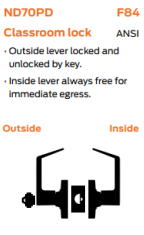|
Lock Guide.
|
A manufacturer’s catalog may show 50+ different lock functions and it’s difficult or impossible to remember how each function works.
Luckily, there are 5 mechanical lock functions that account for the vast majority of locks specified. Add in a few deadbolt functions,
and a basic understanding of electromechanical locks, and you’ve got the most common lock functions.
Luckily, there are 5 mechanical lock functions that account for the vast majority of locks specified. Add in a few deadbolt functions,
and a basic understanding of electromechanical locks, and you’ve got the most common lock functions.
|
Lock functions Passage sets are used where doors do not need to lock. There is no key cylinder and no means to lock a passage set. Privacy sets are used for restrooms or dressing rooms. They can be locked from the inside with a thumbturn or push button/turn for privacy, and they are typically unlocked from the outside using a tool rather than a key. There are several variations on this function, including a hospital privacy which has a thumbturn on both the inside and outside to allow hospital staff quick access to the bathroom. Some privacy functions may also incorporate an indicator to show the locked/unlocked status of the lock. Office locks may be controlled by a key in the outside cylinder, or by a thumbturn or push button/turn on the inside. The outside lever may be left in a locked or unlocked position. And the use of the thumbturn/button provides convenience to the user, but may also allowed an unauthorized person to control the lock. This lock should be used where unauthorized use of the lock is not a concern–perhaps an individual office, or storage closet that does not need to be secured at all times. Storeroom locks are used when the outside lever should be locked at all times. A key is used to retract the latchbolt and open the door; when the key is removed the door is locked on the outside. There is no means to lock/unlock the door from the inside. Typical locations for a storeroom lock would be secure storage rooms, mechanical rooms, and electrical rooms that do not require panic hardware. When a storeroom lock is specified, a door closer may also be needed to ensure that the door is not left open, defeating security. Classroom locks are controlled by a key in the outside cylinder, which locks or unlocks the outside lever. The lock can be left in the locked or unlocked state by using the key, and there is no means of locking or unlocking the door from the inside. This function was originally designed for schools, to prevent students from tampering with the lock, but most new schools have classroom security locks, office function locks or electrified locks. A classroom lock might be used for a common office corridor or suite entry, where key control of the lock is needed, and a thumbturn or push button/turn is not desired. |
|
Deadbolts
Some doors may require the added security of a deadbolt, either combined in a mortise lock with one of the functions above, or as a separate lock. If a door is part of a means of egress, it must unlatch with one operation (with some exceptions for residential dwelling units), so deadbolts are often installed on doors with push/pull hardware. One example would be a door to a restroom with multiple toilet stalls, where the door would typically be push/pull (no latch) but may need to be locked if there is a plumbing problem. Most deadbolts have a cylinder on the outside to project or retract the bolt. On the inside, there may be a thumbturn or key cylinder. If the door is in a means of egress (including the means of egress from a restroom), an occupant must be able to unlatch the door without a key, tool, or special knowledge or effort, so the applications for a key cylinder on the egress side are very limited. A thumbturn on the inside may freely project and retract the deadbolt, or in the case of a classroom function deadbolt the thumbturn will retract the deadbolt but not project it. A classroom function deadbolt prevents an unauthorized person from projecting the deadbolt to secure a room without permission, but provides for safe egress by allowing the thumbturn to retract the deadbolt if an occupant is accidentally locked inside the room by someone projecting the bolt with a key. This function is often used for the door leading to a multi-stall restroom. |
|
Electrified locksets
There are various types of electrified products that can be used as part of an access control system. But electrified lock functions for mortise or cylindrical locks are actually fairly simple. There are two functions that are most commonly used–either electrically locked (fail-safe) or electrically unlocked (fail-secure). An electrified lock is set up so it can be controlled by a card reader, remote release, or other access control device to minimize key use. The electrically unlocked or fail-secure L9092EU mortise lockset is locked on the secure side when there is no power to the lock. To unlock it, power is applied and the lever can then be turned to retract the latch. The latch remains projected until the lever is turned. |








